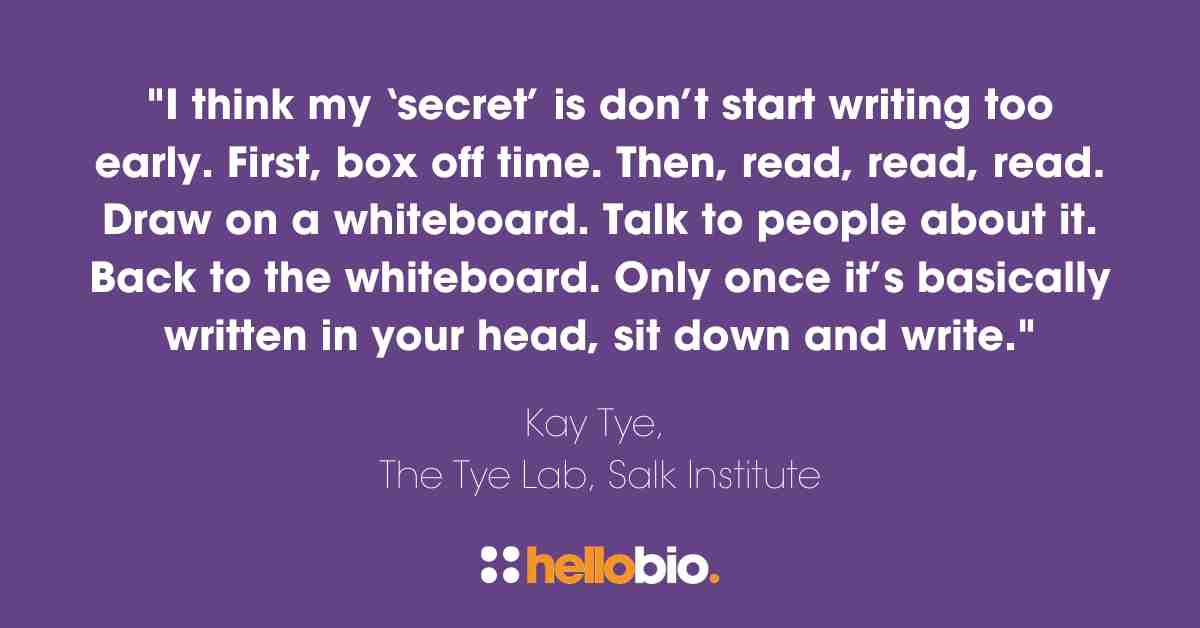The Life Scientists’ Guide to Writing Scientific Papers
Writing scientific papers is essential if you’re going to share your research with fellow life scientists, and the world. No matter how passionate you are about your research, for a lot of scientists the task of putting pen to paper can feel daunting. However, being able to communicate your research methods and findings effectively is a crucial skill. So, how can we make the whole process feel a little less like a chore, and more like an exciting opportunity?
Whether you’re a seasoned pro or you’re about to start on your first paper, there’s always things to be learned and new tips to pick up. And with the right tools and strategies, writing papers can be enjoyable and satisfying. To help you prepare and write your next scientific paper with ease, we’ve spoken to our fantastic community of life scientists around the world and put together this Life Scientist's Guide to Writing Scientific Papers. Here, you’ll find brilliant advice for getting in the right mindset and creating a straightforward, efficient process that makes paper-writing feel focused and structured – and less stressful.
1. Mindset and preparation
When you’ve finished the lab work and that written deadline is looming, it’s tempting to launch yourself straight into writing your paper as soon as possible. However, before you even begin to plan out your paper, it’s always a good idea to take a step back and get yourself into the right mindset. Time taken out to pause and reflect at the start of any project is never wasted time – even though it might feel counter-productive.
Get clear on your ‘why’
Your research is important to the world – that’s why you’re doing it, and it’s the reason you get out of bed in the morning. Sometimes though, when we’re bogged down with details and deadlines, it’s easy to forget why we’re doing it in the first place. Yet being able to communicate why your research matters is crucial for writing an excellent paper, and it’s always the best starting point.
Start by asking yourself: “Why does my work matter?” If you want to, grab a piece of blank paper and write down all the reasons why you do what you do, who you want to help, and what difference you want to make. Then, write out a statement with the ones that inspire you the most. You might even be surprised with what comes up.
Knowing the answer to why your research matters with real clarity will keep you motivated throughout the writing process, and set you up to produce a research paper that genuinely adds value to the scientific community – and society as a whole. In his article Ten Simple Rules for Structuring Papers, scientific adviser Brett Mensh says that effectively communicating why your paper matters in your introduction will keep readers intrigued, and ultimately is likely to increase the number of times your article gets read.
Stuart Maudsley, researcher in the Receptor Biology Lab at the University of Antwerp agrees. He says: “We should all remember that the cause (e.g. a disease) that your research is aimed at is more important than creating another paper.”
Your paper is the vehicle that will get your research out into the world. Reminding yourself of the reason you’re doing the research will strengthen your writing, and set your paper apart.
Think about your readers first
Data, numbers, analysis results – communicating about your research probably involves a lot of figures and abstract concepts. As humans, we make sense of the world through stories and narrative. Scientific writing expert Dr Anna Clemens argues in this article that we tend not to think enough about who is going to read our work before we start writing, and whether they’ll be able to “understand the scientific story” we’re telling them. To improve and focus your writing, Anna suggests keeping your target audience at the forefront of your mind throughout the entire process.
2. Planning and structure
You’ve done the mental preparation, now it’s time to do the physical preparation (don’t worry, we’re not talking about squats and press-ups). Before you open that document and start writing your introduction, you need to create a plan.
Planning your paper
We’ve all had that sinking feeling of opening a blank document, only to be faced with a blinking cursor, tormenting you as you can’t think of a single word to write (writer's block is real, even for scientists). However, it’s rarely a surprise when this happens, because the prospect of writing a whole paper without a structure to work through is overwhelming. You’ve got to break it down, and know where you’re going. After all, you wouldn’t try and navigate without a map.
Planning your paper thoroughly before you start writing (just like we did with this article) will give you an advantage when it comes to putting words on paper. There’s no one way that’s best to plan, as different structures work for everyone. Whether it’s writing a general outline, or setting out your key points onto a page first, planning is the first step to banishing writer's block.
Neuroscientist Kay Tye from the Salk Institute advises not to go sprinting ahead with the writing portion. She told us: “I think my ‘secret’ is don’t start writing too early. First, box off time. Then, read, read, read. Draw on a whiteboard. Talk to people about it. Back to the whiteboard. Only once it’s basically written in your head, sit down and write.”
Structuring your paper
How do you create a structure when you’re starting from scratch? Begin by coming up with a logical framework. In this excellent article for Nature, marine scientist Dr Angel Borja suggests structuring your paper using the IMRAD formation:
- Introduction: What did you do? Why did you do it?
- Methods: How did you do it?
- Results: What did you find?
- And
- Discussion: What does it all mean?
To break it down further, scientific adviser Brett Mensh suggests that:
- The introduction of your paper is for setting the context
- The results are for presenting the information
- The discussion is your conclusion about what the results mean
Brett also shares a great framework for writing individual paragraphs:
- The first sentence of each paragraph defines the context
- The body is where you introduce and discuss the new idea
- The final sentence of each paragraph is a conclusion
Neuroscientist Nina Lichtenberg from UCLA adds: “Arrange your figures in a way that tells the best, most interesting story. Write the methods and results. Make a (super) detailed outline for the intro and discussion before writing. Most of your time should actually be spent planning and brainstorming rather than writing!”
Have confidence in your research
As well as being well-structured, scientific writing should also be clear and confident. In this Nature article, author Dallas Murphy says that scientific writers tend to be afraid to make confident statements, which results in writing that sounds defensive – as if the writer is trying to fend off criticism that hasn’t been made yet. This can make their writing unclear, and leave more opportunities for misinterpretations of their research. So, be bold. State your case concisely and with confidence in order to avoid confusion.
If you aren’t sure about how to structure any part of your paper, don’t let this knock your confidence either. Look at other scientific papers for inspiration. PhD student Sophie Millar from the University of Nottingham says: “I think the best way I 'learnt' to write scientific papers was starting with following a good example of an already published paper on a similar topic.”
3. Writing and productivity
You’re in the zone. You’ve got your plan. You know what you’re talking about. Now, it’s time to get down to it. It’s time to write the actual paper. The most powerful thing you can do at this point is to get into good writing habits. Just like every other habitual action you take automatically – brushing your teeth, driving to work, preparing your favourite meal – you can get into automatic writing habits too, which means you won’t freeze and wonder what to do every time you open up your document. And that’s the key to productivity.
Establish a writing routine
Rachelle Balez, Neuroscientist and Stem Cell Biologist at Illawarra Health and Medical Research Institute suggests writing with a fellow scientist for moral support and to keep you focused. She told us: “My friend and I made Fridays a ‘writing ritual’. We would go to a nice cafe for breakfast, then write together for a couple of hours, have lunch and a break, write for another couple of hours then follow up with a swim/walk to debrief. I know this isn’t practical or possible for everyone, but it helped me to break feeling overwhelmed by writing to it being the highlight of my week. Writing with a science friend was a great source of support as they understand the lingo and thus are great for brainstorming.”
MacKenzie Lemieux, research technician in the Tye Lab at the Salk Institute for Biological Studies, agrees that writing with a friend is an effective habit to get into. She says: “It takes you out of your very confined way of thinking which helps you think about things in new ways and makes you excited to be writing about your work (hopefully).”
If working physically alongside others doesn’t work for you, then establishing a personal writing routine is important. In her guest blog post on tips for productive writing, Post-doctoral Research Fellow at the University of Padova, Maria Montefinese, notes that we tend to believe we must find time for writing. Instead, she argues, we should make time for writing. To get into the habit of making time, start by asking yourself questions like:
- What time of the day am I most focused?
- Where could I squeeze in some extra writing time in my week?
- What activities could move down my priority list to make room for writing?
It’s true that when we take control of our time, we take control of our productivity.
Understand your preferred working style
In her excellent article on work ethic, writer and researcher, Gretchen Rubin posits that people tend to fall into one of two camps when it comes to work style: ‘Marathoners’ or ‘Sprinters’:
- Marathoners prefer to work in a slow and steady way, writing one small chunk of their paper at a time
- Sprinters prefer to work in intense bursts, getting “into the zone” and writing for hours at a time
Are you a Marathoner or a Sprinter? Do you prefer to work more days, with fewer hours? Or fewer days, with more hours? Identifying your ‘inner work timer’ can help you create better writing habits, and a realistic timetable that suits your working style.
Whichever category you fall into, it’s almost universally true that keeping distractions to a minimum is crucial for productivity. Dr James Quinn, research fellow at Massachusetts General Hospital suggests: “My best advice would definitely be to write in blocks with email off and give your phone to someone else (only to be given back to you in emergencies!) or put it in a separate room.”
Dr Chloe Thomas, Post Doctorate at University of Birmingham School of Biomedical Sciences, agrees: “Find a quiet place you can focus and not get distracted. Take regular breaks (45 minutes working, 15 minutes doing something different). Things take time so don’t be hard on yourself if things take longer than expected.”
Keep yourself motivated
Procrastination is something that none of us like to admit we suffer from. The truth is, it affects almost everyone at some point or another. Who feels like sitting down and working when there’s Netflix / food / social media / housework / [insert your distraction of choice here]?
Here’s the truth: you’re hardly ever going to feel like putting in the hard work. We’re not programmed that way. Our brains are wired to want short-term rewards. You can’t wait until you “feel like writing”, because chances are, you won’t feel like it often enough to get the work done. Remember when you were a kid, and your parents made you do the things you didn’t want to do? Now you’re an adult, you’ll sometimes need to parent yourself and use self-discipline to get your work done. We know that’s easier said than done, but there are some “brain hacks” you can use to help you motivated.
In her book The 5 Second Rule, CNN presenter Mel Robbins argues that we make decisions based not on what we know we need to do, or based on our goals, but instead based on how we feel in the moment. This is what leads to procrastination. Because let’s face it, when do we ever feel like doing any task that we perceive as long and laborious?
Robbins’ suggested solution – backed by scientific research – is to “trick” your brain into taking action before it has time to back out. To do this, countdown like a rocketship: “5, 4, 3, 2, 1” and then take the action. It’s all about activation energy and momentum: and it always takes more energy to get you started than to keep you going. Are you ready? 5, 4, 3, 2, 1... write!
Kate Secombe, PhD Candidate from the University of Adelaide shared her thoughts on combating procrastination: “One thing I have learnt recently is not to wait until you feel like writing – that’s a good way to procrastinate! Set up a regular time to write and then do it!”
4. Editing and reviewing
Once you’ve written your draft, the final step is to edit and review your paper. It’s important not to leave this to the last minute, as you’ll deliver the best quality paper possible if you leave yourself enough time to edit your paper thoroughly, review it several times, and perhaps even discuss it with others.
Pick a concise, compelling title
In this guide to structuring a science paper, Dr Angel Borja advises writing descriptive but concise headlines. She says: “Readers are the potential authors who will cite your article, so the first impression is powerful.”
Neuroscience PhD graduate Niklas Michel adds: “Make the title a snappy, active and direct statement summarizing the finding, like ‘this does that’. Avoid vague words like ‘characterization’, ‘identifying’, etc. Apply that principle to section titles too. Adopt an active writing style throughout the paper for readability and clarity, instead of old school passive ‘this was done by that.’”
A good way to think of your paper title is like a “one line advertisement” for months, maybe years of research. This is your way to entice readers (and journal editors) to dive into your research, so make it count. If you’re struggling to choose a title, write out as many options as you can think of and ask for feedback on them from your peers or colleagues.
Check your spelling and grammar
Producing a high quality paper requires excellent presentation, and spelling and grammar are a big part of this. If you know that this isn’t your strong point, ask a trusted friend or colleague to proof-read your paper for you.
Make sure you pay special attention to:
- Spelling of names and references
- Year of publications
- Abbreviations
- Punctuation
- Any specialist language that a spell-checker might not pick up on
This might all seem like a lot of extra work, but it’s worth it if you want your paper to be published. PhD student Sophie Millar from the University of Nottingham adds: “Be prepared for many many revisions – but each one makes it better and that’s how you learn.”
Get feedback
In her guest blog for us, Research Associate at the University of Bristol, Jasmine Pickford recommends getting feedback from peers and colleagues throughout the writing process – not just at the end. She says: “Those who are less involved in the research day-to-day will be able to spot gaps or suggest experiments you might not think of until you come to writing your results up – and you wish you’d have thought of before.”
Although continuous feedback is important throughout your writing process, it’s best not to edit your words before you’ve laid them all out in a draft – or you’ll lose your flow and momentum. Scientific Editor from the University of Antwerp, Dr Bronwen Martin, advises: “First get a full rough draft written down and then modify / tweak the text. Writing a good paper takes many modifications! If you can, choose to publish your paper Open Access so that everyone can freely read it.”
Summary
Writing a scientific paper can feel like a big challenge for a lot of life scientists, especially if you’re writing a paper for the first time. And ultimately, that feeling of challenge is what will make it feel so rewarding in the end. Any passionate scientist who’s published a paper will tell you that seeing months, even years of hard work all typed up and out there in the world for all to see is an incredible feeling.
And any time the writing process gets you down, remember that there's a lot of support out there for you. Stay connected with your mentors, teachers, and peers – you’re not alone. Everyone’s paper writing process will be different, and there’s no right way to do it. We hope that this guide has helped you feel more focused and confident. And if you have any more tips you’d like to share, we’d love to hear from you in the comments.
_______________________________
If you enjoyed this article, why not check out the other resources available on our blog. We are passionate about supporting life scientists including early career life scientists and PhD students - with really low-priced reagents, antibodies and biochemicals, early career scientist grants, and resources to help with both personal and professional development. We know how tough it is - so we hope you find these helpful!
More General Support for Life Scientists
For advice on wellbeing, dissertations, presenting at conferences, wellbeing, PhD support, networking and lots more, we have a huge range of articles to help - just click below:
Save up to 50% on our high purity reagents...
When you get to the stage of planning your experiments, don't forget that we offer a range of low-cost, high-purity agonists, antagonists, inhibitors, activators, antibodies and fluorescent tools (yes - they really are around half the price of other suppliers!) You can use our Quick Multi-Search Tool to search for lots of products in one go, and the range includes:
- Enzyme inhibitors and activators
- Chemogenetic ligands
- Ion channel modulators
- GPCR & ionotropic receptor ligands
- Cell biology reagents & biochemicals
- ValidAbs™ - a new range of highly validated antibodies
Technical resources
Try our Molarity Calculator: a quick and easy way to calculate the mass, volume or concentration required for making a solution.
Try our Dilution Calculator: an easy way to work out how to dilute stock solutions of known concentrations
We also offer a comprehensive range of technical resources including antibody protocols and methods, product guides and mini-reviews:
And finally, don't forget to check back in with our blog regularly for our latest articles. If there’s something you’d love to contribute to the community, whether that’s an interview or article, drop us a line at hello@hellobio.com
---


































